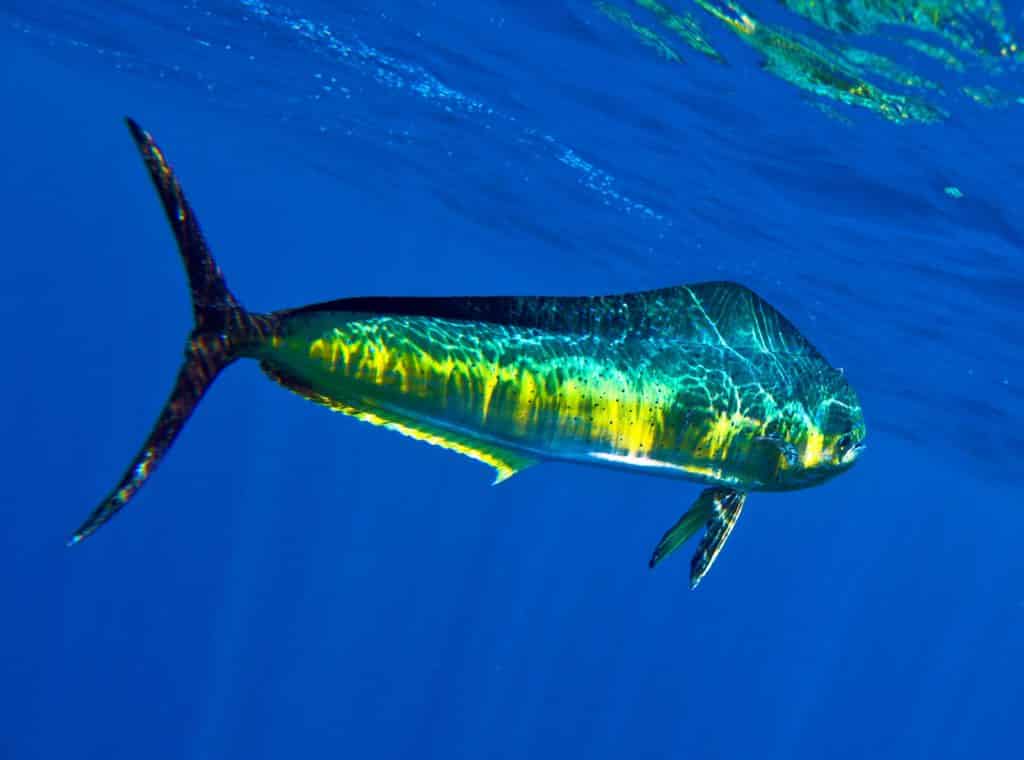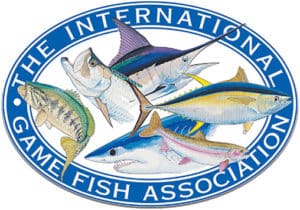Contact us if your target is Mahi-mahi (Dolphin) in Costa Rica
See our Mahi-mahi (Dolphin) Photo Gallery
VIDEO: How to Catch a Mahi-mahi

Mahi-mahi (Dolphin)
It is also called Dolphin in the USA and in Costa Rica is Dorado, in the North Pacific coast the best time is from May to October, they are found hanging around rubble. In the Central Pacific coast it usually appears at the beginning of the rains, at the end of May. In the Southern zone the best time is from May to October.
It is one of the favorites in the sportfishing world.
Mahi-mahi, also known as dolphinfish or simply dolphin, is a highly prized game fish found in tropical and subtropical waters around the world. They are part of the Coryphaenidae family, which also includes the pompano dolphinfish.
Mahi-mahi are known for their bright colors and iridescent scales, which can range from a deep blue to a vibrant green on the back and sides, with golden hues on the belly. They have a distinctive dorsal fin that runs the length of their back and a forked tail. They can grow up to 6 feet in length and weigh up to 80 pounds, but most caught by anglers are between 15-30 pounds.
Mahi-mahi are fast swimmers and are known to put up a strong fight when hooked. They are commonly caught using trolling methods, with lures or dead bait. They can also be caught using fly fishing and casting methods. They are considered a highly prized game fish and are a popular target for sportfishermen.
Mahi-mahi are also considered a delicacy and are highly sought after for their firm, white flesh, which has a mild, sweet flavor. They are commonly used in a variety of dishes, including sushi, ceviche, and grilled preparations.
Due to their popularity, commercial fishing for Mahi-mahi is also common in many parts of the world. It is important to practice responsible fishing, to ensure that populations of Mahi-mahi remain healthy and sustainable.
Things to know about Mahi-Mahi (Dolphin)
Mahi-mahi lives around 7 years so its growth is fast. Normally it weighs between 10 pounds and 35 pounds. It has the reputation to be always hunting due to its appetite. It reaches up to 50 knots. It has a golden color with blue and green, that’s why in Spanish it is called Dorado (means Golden). It will maintain that color only when you do catch and release, if you keep it turns grey literally in seconds.
Males have a flat forehead and they are larger than the females. Mahi-Mahi is well known for its great flavor, white meat that is firm so it is common finding it in cevice, grilled or fried.
Mahi-mahi eating habits
The Mahi-mahi known for being an aggressive predator, always on the look of flying fish, goldfish, octopus, tuna, and squid. It feeds on the surface.
What parts of Costa Rica can you find Mahi-mahi (Dolphin)?
Since Mahi-mahi loves warm water, in Costa Rica it is found throughout the Pacific and Caribbean coast.
It is attracted by anything it finds floating: sargassum, logs, buoys, so this is where you should either start trolling or throw your popper to get some bites.
What are the recommended baits for catching Mahi-mahi (Dolphin)?
The Mahi-mahi is always looking for anything it can eat so you can try with lures of you can use tuna, ballyhoo, garrita keg, smooth or squid.
The speed of the fishing charters should be between 6 and 12 knots and the bait between 15-20 yards in order to be in the clear water where the Mahi-mahi can track it.
Important note to catch Mahi-mahi (Dolphin)
Open your eyes to find birds. That is a sign that there is school of fish, the perfect place where Mahi-mani feeds. Same of flying fish, when they are around most likely there are Mahi-mahi after them.
About Mahi-mahi Fishing
Mahi mahi fishing is a species of marine fish found in tropical and subtropical waters around the world. They are also known as dorado or dolphin fish, although they are not related to the mammal dolphin. Mahi mahi are known for their vibrant colors, which can range from bright greens and yellows to blues and purples. They are also known for their strong fighting ability and their acrobatic jumps when hooked.
Mahi mahi fishing typically takes place in the open ocean and can be done from both large commercial fishing vessels and smaller private boats. Anglers typically use specialized equipment, such as heavy-duty fishing rods and reels, to handle the strength and size of mahi mahi. Baits and lures, such as live baitfish, dead baitfish, and artificial lures, are used to attract the fish.
Mahi mahi can be caught using various fishing techniques, such as trolling, casting, and live baiting. Trolling is the most common method, using various lures and baits to cover a larger area of the sea. Live baiting is also a popular technique, where live baitfish are used to attract the mahi mahi.
Mahi mahi are considered a prized catch for sport fishermen, due to their strong fighting ability and vibrant colors. They are also considered a delicacy in some countries and are used for food in local communities.
Mahi mahi populations are considered stable in many regions, but overfishing and unsustainable fishing practices have led to declines in some areas. Therefore, conservation efforts have been implemented in some regions to protect these fish and ensure their populations remain sustainable.
It is also important to note that Mahi mahi fishing can be physically demanding, as they are strong fighters and can put up a long and hard battle once hooked. They are also known for their spectacular jumps, which can make for an exciting fishing experience. International Game Fish Association (IGFA) has specific rules and regulations for anglers to follow while catching mahi mahi and other big game fishes.




